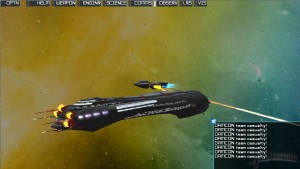So there’s never been a good Star Trek game. No really. Go and check. There have been a few decent ones. Elite Force was ok. Bridge Commander was…. look, I’ll just say it again, there never been a really good Star Trek game. Not till now. Artemis may not have an official license, but it’s as close as you can come to sitting on the same seat as Picard, Kirk or the other ones.

Artemis is also a hugely original game. There might be other games like it, but I’ve never encountered them. It’s a multiplayer ship simulator, where each person takes on a single role, and where communication and team work are the key to victory. Each person uses their own computer, with one machine running a dedicated server that handles the actual simulation. It’s best if you make this main machine the one that’s connected to the biggest TV you have (or even a projector), as it also acts as the main views screen for the game. Meanwhile, on their own screens each player mans their station, and each station is different and unique. Each player will have access to different data about the game world, and they will have their owns roles, tasks and responsibilities. In other words, each player is effectively a single member of a star ship crew, with a single Captain issuing orders and making decisions about what to do next. It is the responsibility of each crew member to actually carry out those orders.
There are six available positions you can play, and while some are more enjoyable than others, they are all important and become more satisfying as you learn their intricacies. Helm is perhaps the simplest, and the helms-person actually flies the ship, with both warp and impulse engine speeds available.

Tactical controls the weapons systems on the ship, with mines, torpedoes, nukes and beam weapons all available. Science is responsible for processing and relaying information on everything happening outside the ship, and in particular must scan constantly and tell the Captain what is happening with other ships and space stations. Comms meanwhile is all about communicating with other ships and stations, while the player in engineering must allocate power to appropriate systems and manage damage repair crews. The last position is reserved for the Captain, who doesn’t have a specific station, but rather commands the crew and makes decisions.
The Captains role is initially the hardest, beacuse until they have some understanding of all the other stations they won’t know what orders to give. Once they learn a little bit about each however, the whole experience starts to click into place. As long as the Captain knows what they’re doing, each other member of the team only really needs to know their own station. Certainly it will take a little while before everyone understands how to play, but if each player takes a cursory glance at their section of the instruction manual, you can have some chaotic fun on your first mission, and by the time you get to your second and third you’ll be a fairly proficient crew.

When you start your first mission you might be a little bit lost, but the goal of the game is fairly simple. Protect friendly space stations. Help Federation ships. Defeat enemy ships in combat. It’s at this early stage of the game where your science and comms officers will be busiest. The science officer will be scanning the overall map and reporting to the Captain on how many enemy ships are on the scanner, while the Comms officer will begin receiving messages from allied ships and stations requesting help. It’s up the Captain to plan out a course of action now.
Once the action is underway, the game is stressful, but never overwhelming, fast-paced, but never hard to follow and it will make you shout at your friends, but you’ll laugh with them far more. The design is masterful, and the way that every single player has an essential role to play is what really makes the game work. Comms might seem like the most dull job, when you’re in the middle of combat they are the crew member who might get a troublesmome enemy to surrender by asking them to stand down, or their message for support might get through to an allied vessel that will save the day. Comms also has a role to play in the grander strategy set out by the Captain, as they will be messaging space stations and requesting supplies far in advance.
 Engineering meanwhile is perhaps the most complex role to play, as it involves commanding repair crews. Just like in a series like Star Trek, the Engineer will constantly be issuing damage reports to the Captain, but they will also have too little time to consult on every single decision made and as such, will have to make tough judgement calls. In one mission we played, helm was trying to turn our ship as our shields crumbled at the front, and it was only a split second decision by the Engineer to allocate more power to the impulse drive that let us escape certain defeat. When the helmsman got the extra power, the ship turned very quickly and we all congratulated our Engineer on making a good choice in a tough situation. The sense of camaraderie we got from that early mission endeared us to the game from their on.
Engineering meanwhile is perhaps the most complex role to play, as it involves commanding repair crews. Just like in a series like Star Trek, the Engineer will constantly be issuing damage reports to the Captain, but they will also have too little time to consult on every single decision made and as such, will have to make tough judgement calls. In one mission we played, helm was trying to turn our ship as our shields crumbled at the front, and it was only a split second decision by the Engineer to allocate more power to the impulse drive that let us escape certain defeat. When the helmsman got the extra power, the ship turned very quickly and we all congratulated our Engineer on making a good choice in a tough situation. The sense of camaraderie we got from that early mission endeared us to the game from their on.
Similarly the science officer has a key role. They are the eyes of the ship, and they will always have more information about the situation than everyone else. With an eye on the big picture, they will be monitoring the movements of enemy fleets, while when combat gets underway they will be scanning the enemy ships and telling the tactical officer about possible weaknesses in their opponents. This was my personal favourite role on the ship, as I enjoyed having an idea of the wider situation across the quadrant.
 There’s one little decision that I really love in Artemis. It’s a perfect little idea, and it shows how well the developers understand group dynamics and multiplayer games. To change whats shown on the main screen, the Captain has to ask either helm or tactical. So when comms tells you an enemy is close and hailing you, the Captain literally says, “Onscreen”. And then one of the two (whoever is not busy) brings up the main screen. What you see then is a fairly basic game, and a simple space ship (probably an enemy ship). It doesn’t matter that the graphics aren’t amazing though. It doesn’t matter that the space ship is generic, or that the resolution isn’t perfect. All that matters is that the Captain just roleplayed, probably without realizing it. The game made him do that. And everyone else is roleplaying too. Some of them won’t even see the main screen (our Engineer, appropriately enough, was in a side room). But the game is going on in everyone’s head. The game takes place in the space between the players. In the way they talk to each other, in how they work together, and in the decisions they come to as a team. It’s pure make believe in the best possible way. It’s as close to being the crew of a space ship as any of us are likely to get, and whether you’ve always wanted to take your seat on the Galactica, the Enterprise or the Millennium Falcon, this is a game you absolutely have to play.
There’s one little decision that I really love in Artemis. It’s a perfect little idea, and it shows how well the developers understand group dynamics and multiplayer games. To change whats shown on the main screen, the Captain has to ask either helm or tactical. So when comms tells you an enemy is close and hailing you, the Captain literally says, “Onscreen”. And then one of the two (whoever is not busy) brings up the main screen. What you see then is a fairly basic game, and a simple space ship (probably an enemy ship). It doesn’t matter that the graphics aren’t amazing though. It doesn’t matter that the space ship is generic, or that the resolution isn’t perfect. All that matters is that the Captain just roleplayed, probably without realizing it. The game made him do that. And everyone else is roleplaying too. Some of them won’t even see the main screen (our Engineer, appropriately enough, was in a side room). But the game is going on in everyone’s head. The game takes place in the space between the players. In the way they talk to each other, in how they work together, and in the decisions they come to as a team. It’s pure make believe in the best possible way. It’s as close to being the crew of a space ship as any of us are likely to get, and whether you’ve always wanted to take your seat on the Galactica, the Enterprise or the Millennium Falcon, this is a game you absolutely have to play.
You can install Artemis on six computers, so you can have a whole crew with just one purchase. Get the game here.
